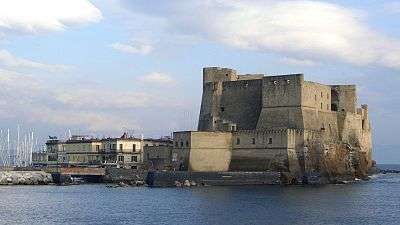Castel dell'Ovo
Coordinates: 40°49′40″N 14°14′53″E / 40.827872°N 14.248012°E
Castel dell'Ovo (in English, Egg Castle) is a seaside castle in Naples, located on the former island of Megaride, now a peninsula, on the Gulf of Naples in Italy. The castle's name comes from a legend about the Roman poet Virgil, who had a reputation in medieval times as a great sorcerer and predictor of the future. In the legend, Virgil put a magical egg into the foundations to support the fortifications. Had this egg been broken, the castle would have been destroyed and a series of disastrous events for Naples would have followed. The castle is located between the districts of San Ferdinando and Chiaia, facing Mergellina across the sea.
History during the Roman era
The Castel dell'Ovo is the oldest standing fortification in Naples. The island of Megaride was where Greek colonists from Cumae founded the original nucleus of the city in the 6th century BC. Its location affords it an excellent view of the Naples waterfront and the surrounding area. In the 1st century BC the Roman patrician Lucius Licinius Lucullus built the magnificent villa Castellum Lucullanum on the site. Fortified by Valentinian III in the mid-5th century, it was the site to which the last western Roman emperor, Romulus Augustulus, was exiled in 476.[1] Eugippius founded a monastery on the site after 492.
History from Norman to Napoleonic conquests
The remains of the Roman-era structures and later fortifications were demolished by local residents in the 9th century to prevent their use by Saracen raiders. The first castle on the site was built by the Normans in the 12th century. Roger the Norman, conquering Naples in 1140, made Castel dell 'Ovo his seat. The importance of the Castel dell'Ovo began to decline when king Charles I of Anjou built a new castle, Castel Nuovo, and moved his court there. Castel dell'Ovo became the seat of the Royal Chamber and of the State Treasury. It also served as a prison. In 1191, Empress Constance of Holy Roman Empire was captured during her struggle with her nephew Tancred, King of Sicily for the crown of Sicily, and Sicilian Chancellor Matthew d'Ajello wrote to Tancred persuading him to lock Constance in the sea-surrounded Castel dell'Ovo to be better-guarded, and wrote to nobleman Aligerno Cottone in charge of defending Naples ordering him to "ut imperatricem in Castro Salvatoris ad mare benè custodiat" (guard the empress in Castle of the Savior (i. e. Castel dell'Ovo) in the sea properly). However, Constance would be released the next year and finally become Queen of Sicily. In 1268, King Conradin was imprisoned here before his trial and execution. In 1381, Queen Joanna I of Naples was also imprisoned there for a time after forced to surrender to her enemy Charles of Durazzo, the future Charles III of Naples, before her final assassination.
The current appearance dates from the Aragonese domination (15th century). It was struck by French and Spanish artillery during the Italian Wars; in the Neapolitan Republic of 1799 its guns were used by rebels to deter the philo-Bourbon population of the city.
After a long period of decay the site got its current appearance during an extensive renovation project started in 1975.
Present
In the 19th century a small fishing village called Borgo Marinaro, which is still extant, developed around the castle's eastern wall. It is now known for its marina and restaurants. The castle is rectangular in plan, approximately 200 by 45 metres at its widest, with a high bastion overlooking the causeway that connects it to the shore; the causeway is more than 100 metres long and a popular location for newlyweds to have their wedding photos taken. Inside the castle walls are several buildings that are often used for exhibitions and other special events. Behind the castle there is a long promontory once probably used as a docking area. A large round tower stands outside the castle walls to the southeast.
_(14963100053).jpg) Cannon on top of the castle
Cannon on top of the castle_(15397707910).jpg) The entrance to Castel dell'Ovo from the north
The entrance to Castel dell'Ovo from the north The castle seen from the west
The castle seen from the west_(15584125702).jpg) Inside the castle
Inside the castle_(15580624511).jpg) Inside the castle
Inside the castle
References and sources
- References
- ↑ This identification was definitively made by Karl Julius Beloch, Campanien (Berlin, 1879), and was accepted by Thomas Hodgkins. Italy and her Invaders (Oxford, 1885), vol. 4 p. 192 n.3
- Sources
- I castelli di Napoli. Elio De Rosa. 1992.
External links
![]() Media related to Castel dell'Ovo at Wikimedia Commons
Media related to Castel dell'Ovo at Wikimedia Commons